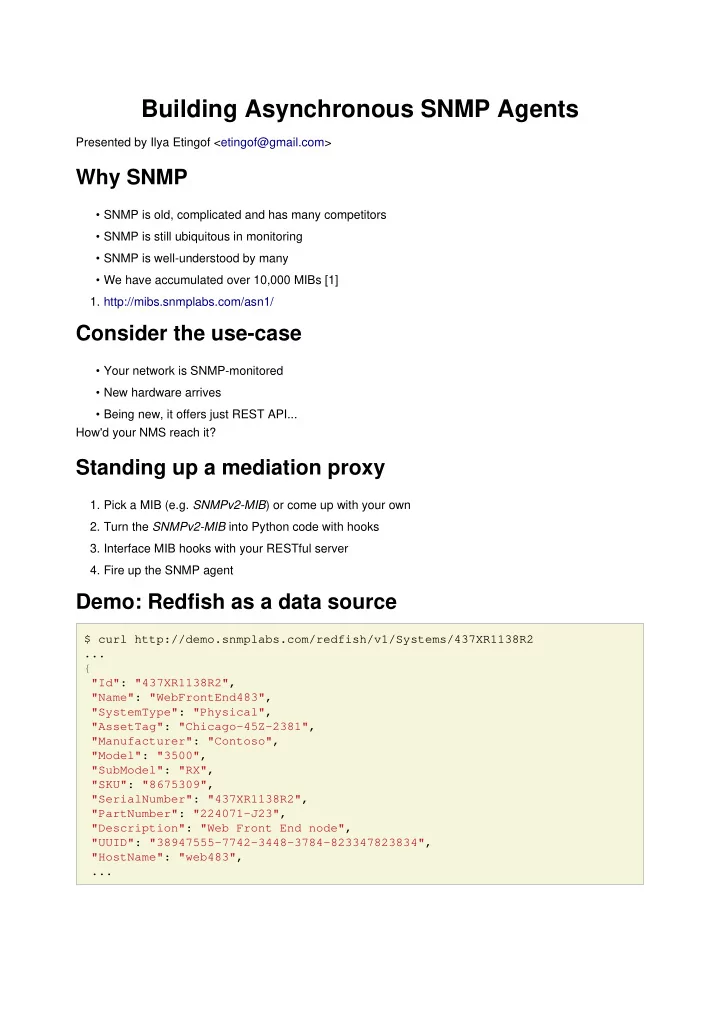

Building Asynchronous SNMP Agents Presented by Ilya Etingof <etingof@gmail.com> Why SNMP • SNMP is old, complicated and has many competitors • SNMP is still ubiquitous in monitoring • SNMP is well-understood by many • We have accumulated over 10,000 MIBs [1] 1. http://mibs.snmplabs.com/asn1/ Consider the use-case • Your network is SNMP-monitored • New hardware arrives • Being new, it offers just REST API... How'd your NMS reach it? Standing up a mediation proxy 1. Pick a MIB (e.g. SNMPv2-MIB ) or come up with your own 2. Turn the SNMPv2-MIB into Python code with hooks 3. Interface MIB hooks with your RESTful server 4. Fire up the SNMP agent Demo: Redfish as a data source $ curl http://demo.snmplabs.com/redfish/v1/Systems/437XR1138R2 ... { "Id": "437XR1138R2", "Name": "WebFrontEnd483", "SystemType": "Physical", "AssetTag": "Chicago-45Z-2381", "Manufacturer": "Contoso", "Model": "3500", "SubModel": "RX", "SKU": "8675309", "SerialNumber": "437XR1138R2", "PartNumber": "224071-J23", "Description": "Web Front End node", "UUID": "38947555-7742-3448-3784-823347823834", "HostName": "web483", ...
Demo: system name $ ls -l SNMPv2-MIB.txt -rw-r--r-- 1 ietingof staff 29305 Jul 24 07:54 SNMPv2-MIB.txt $ cat SNMPv2-MIB.txt ... sysName OBJECT-TYPE SYNTAX DisplayString (SIZE (0..255)) MAX-ACCESS read-write STATUS current DESCRIPTION "An administratively-assigned name for this managed node. By convention, this is the node's fully-qualified domain name. If the name is unknown, the value is the zero-length string." ::= { system 5 } ... Demo: Pythonize SNMPv2-MIB $ mibdump --destination-format pysnmp --destination-template \ pysnmp/mib-instrumentation/managed-objects-instances.j2 SNMPv2-MIB $ ls -l SNMPv2-MIB.py -rw-r--r-- 1 ietingof staff 16839 Jul 24 07:54 SNMPv2-MIB.py Looking inside the SNMPv2-MIB.py : ... class SysnameObjectInstance (MibScalarInstance): def readTest(self, varBind, **context): # Put your code here MibScalarInstance.readTest(self, varBind, **context) def readGet(self, varBind, **context): # Put your code here MibScalarInstance.readGet(self, varBind, **context) ...
Demo: add REST API call REST_API_URL = 'http://demo.snmplabs.com/redfish/v1/Systems/437XR1138R2' executor = concurrent.futures.ThreadPoolExecutor() def readGet(self, (name, value), **context): cbFun = context['cbFun'] def done_callback(future): rsp = future.result() value = self.syntax.clone(rsp['HostName']) cbFun((name, value), **context) future = executor.submit(load_url, REST_API_URL) future.add_done_callback(done_callback) Demo: stand up SNMP agent Configure SNMP Command Responder: $ pip install snmpresponder $ cp SNMPv2-MIB::sysName.py /etc/snmpresponder/managed-objects/ $ snmpresponderd And query it: $ snmpget -v2c -c public localhost SNMPv2-MIB::sysName.0 SNMPv2-MIB::sysName.0 = STRING: web483 Why it all matters • SNMP is still widely used in monitoring • But data sources may vary • The snmpresponder [1] tool offers universal mediation layer 1. https://github.com/etingof/snmpresponder Thank you ;-)
Recommend
More recommend